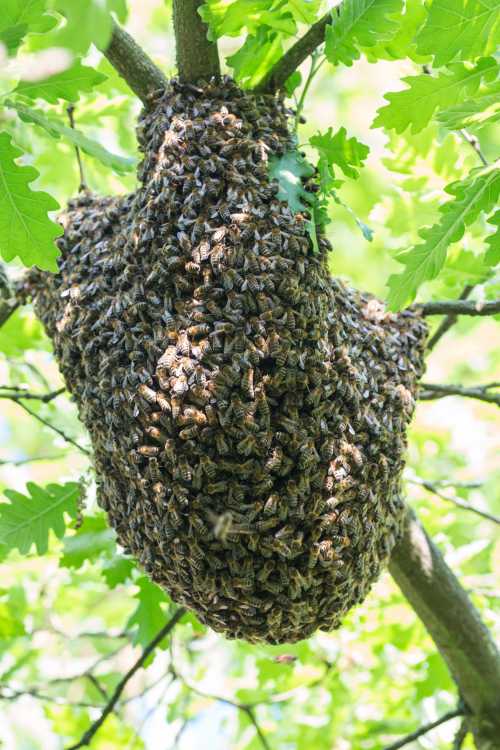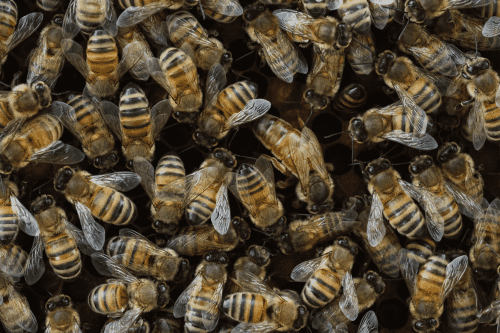What Is Royal Jelly?
In honey bees, nurse bees provision larvae with glandular secretions called jelly.
This jelly is a glandular secretion – actually from the hypopharyngeal glands, which are a pair of long glands coiled in the sides of the heads of young worker honey bees.
The hypopharyngeal glands of young worker bees are particularly productive between 6 to 12 days after she has emerged from her cell.
Research shows that workers bees with developed hypopharyngeal glands consume more pollen1.
Royal jelly and making a queen
For the first 3 -4 days, all bee larvae receive a jelly that is low or almost free of pollen. This jelly contains all the nutrients needed for growth and development of bee larvae.
Later, the larvae continue to be fed on jelly, but not all jelly is the same - it might be 'drone jelly', 'worker jelly' or 'royal jelly' depending on the future role in the colony5.
Queen honey bees are fed royal jelly from larva through to adulthood.
Adult honey bee workers feed on honey and pollen.
Royal jelly and bee health
It is notable that the queen has a significantly longer lifespan than the worker females.
Hypopharyngeal glands are less developed in workers poisoned with pesticides2,3.
It is believed by some scientists, such as Paulus et al, that substances
are passed on to bees via royal jelly, that protect bees from diseases, such as
American Foulbrood, because it contains a substance called Bee defensin-16.
Paulus et al noted:
“We recently identified the antimicrobial peptide bee defen-sin-1 in RS honey.
This peptide (also known as royalisin) was previously identified in honeybee hemolymph, the insect equivalent of blood in honeybee head and thoracic glands and in royal jelly, the major food of queen bee larvae but had never been detected in honey.
Bee defensin-1 has potent activity but only against Gram-positive bacteria including B. subtilis, S. aureus, and Paenibacillus larvae.
The latter species is the causative agent of the devastating bee larval disease American Foulbrood.
Invertebrates strongly rely on antimicrobial peptides (AMPs) as part of their innate immune system for defence against micro-organisms.
In honeybees, four types of AMPs are produced in the hemolymph after experimental infection with E. coli, that is, hemenoptecin, bee defensin-1, apidaecin and the group of abaecin peptides.
Each of these AMPs has a distinct spectrum of antimicrobial activity, and collectively these peptides cover all major classes of microorganisms.
American foulbrood is a devastating disease that specifically affects bee larvae. Infection with P. larvae occurs via the digestive tract and results in severe mortality among larvae during the first 48 h following egg hatching.
Bee defensin-1, but none of the other honey AMPs, has been identified in royal jelly and honey, the major food sources for bee larvae.”
Composition of royal jelly
The composition of royal jelly can vary, but is is composed mainly of water, sugar, proteins, lipids, vitamins and some mineral salts4.
REFS:
- Hrassing N, Crailsheim K. (1998) Adaptation of hypopharyngeal gland development to the brood status of honeybee (Apis mellifera L.) colonies. Journal of Insect Physiology 44:929–939.
- Heyden K, Gobin B, Arckens L, Huybrechts R, Billen J.(2011) The effects of four crop protection products on the morphology and ultrastructure of the hypopharyngeal gland of the European honeybee, Apis mellifera. Apidologie 42:103–116.
- Hatjina F, Papaefthimiou C, Charistos L, Dogaroglu T, Bouga M, Emmanouil C, Arnold G. (2013) Sublethal doses of imidacloprid decreased size of hypopharyngeal glands and respiratory rhythm of honeybees in vivo. Apidologie.
- Fratini et al: Royal Jelly: An ancient remedy with remarkable antibacterial properties; Microbiological Research Volume 192, November 2016, Pages 130-141.
- Matteo A. Lucchetti, Verena Kilchenmann, Gaetan Glauser, Christophe Praz and Christina Kast. Nursing protects honeybee larvae from secondary metabolites of pollen. Proceedings of the Royal Society B: Biological SciencesVolume 285, Issue 1875.
- Paulus H. S. Kwakman and Sebastian A. J. Zaat. Antibacterial Components of Honey, IUBMB Life, 64(1): 48–55, January 2012
If you found this page helpful or interesting, I'd really be grateful if you would share it with others - if not this page, perhaps another, such as Gardening For Bees.
Thank you so much :) .




